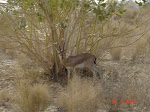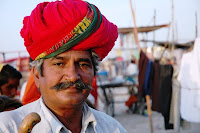Barmer is an arid, drought prone area with acute water shortage. Several times The drought continues for year after year sometimes upto four years in a row. During my stay here even I have witnessed several droughts. “Kaal padyo hai” -that’s what people say( “a” of akaal is silent) whenever there is a tough season. Drinking water become scarce and food insecurity is not only for human but also cattle (often called as trikaal- shortage of water, food and fodder). People start migrating to bigger cities. Many reports claim loss of thousands of cattle during drought.
The biggest challenge during drought and even non drought years is availability of fresh drinking water. The situation deteriorates so much during drought that water has to be transported in tankers even in villages. And you have to pay for getting these tankers- unless it is free by government of some other NGOS.
The situation is no better in the district headquarters too. The district has only two prominent towns- Barmer and Balotra. And daily in the newspapers- particularly during summer- you would find a report or two on the water crisis in the town. There are news of protests by housewives, municipal members, politicians and NGOs – all demanding adequate drinking water.
I live in ‘a posh area’ of Barmer- Mahaveer Nagar. This colony is supposed to have less power cuts,good water supply better facilities and best infrastructure in the district. Let me narrate what good water supply means. It means getting water once in three days- if one is fortunate. Else the waiting can prolong as much as a week. During peak summer the water supply can wait for even more than 10 days. And the option left for the people is to purchase water from private vendors. In one tanker you get around a 2500-3000 liters. The private water suppliers in Barmer town fetch water from village Gehun- 5 kms from the headquarters. The rate of such tankers appreciates to more than 30-40% during summer. And as they are ‘private’ they work on their own terms!
And the most ironic yet interesting part is that a majority of these private water suppliers have contact points outside the government PHED office!
The fact remains that Barmer has an average rainfall of only 277 milimetres. The status of ground water is equally dismal. Most of the areas of the district is classified as the dark zone. And in places where the ground water is available, it is contaminated with high fluoride content.
Even within the town, the administration fulfills only the 70% of the water demand. The remaining 30% is managed by private tanker suppliers.
Today is 24th of June. In many of the districts monsoon came few weeks back. Some districts are even flooded. But here in Barmer people are still waiting for 'बरखा रानी “. And let me tell you, the reception that the first rains of the season are going to get here would be unprecedented. You can guess, why so!
Anwesha
दुष्यंत कुमार
16 years ago












